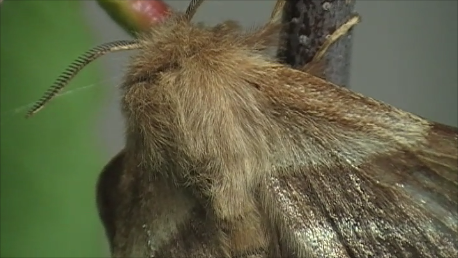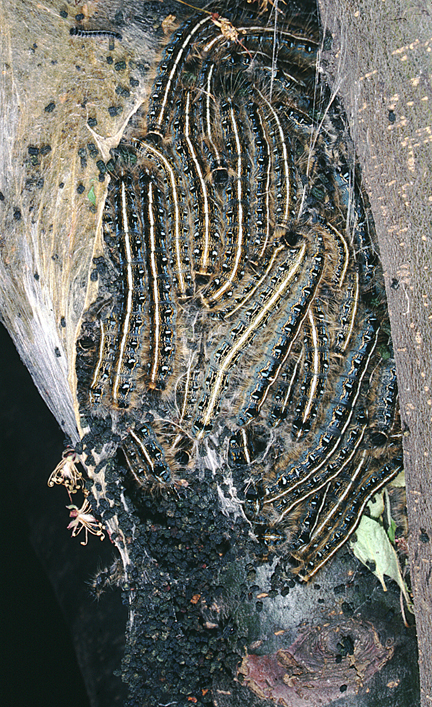Heliothermy - Eastern tent caterpillars are among the earliest of caterpillars to appear in the spring. Because the early spring weather is often cold, the caterpillars rely on the heat of the sun to elevate their body temperatures to levels that allow them to digest their food.
Studies show that below 15°C (59° F) the caterpillars are unable to process the food in their guts. They elevate their body temperature by basking in the sun. When basking, the caterpillars typically pack together tightly, reducing heat loss due to convective currents. The long setae that occur on the caterpillars also serve to stem convective heat loss. The caterpillars may aggregate on the surface of the tent or within the structure.
The tents act as miniature glass houses, trapping the heat of the morning sun and allowing the caterpillars to warm more quickly than they would if they remained outside the tent. Outdoor studies showed that operative models of basking, aggregated caterpillars achieved temperature excesses (Tbody-Tambient) of as much as 44°C in direct sunlight. Live caterpillars, however, move to shade before overheating and could not tolerate such extreme temperature excesses.
Metabolic heat trapping - As shown for other caterpillars the later instars of eastern tent caterpillars are capable of generating a small amount of metabolic heat while they digest their meals. When recently fed caterpillars pack tightly together, the temperature of the caterpillars in the interior of the mass may be several degrees Celsius above ambient temperature even in the absence of a radiant heat source. It is unclear whether this small heat gain has a significant effect on the rate of caterpillar growth.
On cold evenings, the moths need to warm their flight muscles before they can take flight. They do this in place by contracting and relaxing the large muscles of the thorax in rapid-fire bursts. The metabolic heat produced by this "shivering" is trapped by the long fur-like scales that insulate the thorax. When the muscles of the thorax warm sufficiently, typically to at least 38°C (100° F) the moths can take flight.
Time-lapse video recorded inside a refrigerated cabinet comparing the temperature gain of a tent irridated with a sunlamp to air temperature. The temperature differential at the end of the run was approximately 27°C (50° F).
Although the coldest temperatures the caterpillars need to endure occur in the early spring when they are small, in the more northern parts of their range cold temperatures can persist late into the season. This colony of caterpillars was caught in a snowstorm that occured in mid-May when the larvae were nearly fully grown.









